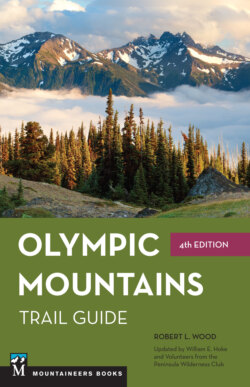Читать книгу Olympic Mountains Trail Guide - Robert Wood - Страница 14
На сайте Литреса книга снята с продажи.
STREAMS AND LAKES
ОглавлениеThe rounded, dome-like configuration of the Olympic Mountains has resulted in a pattern of rivers that spiral outward from the central heights. These rivers, numbering perhaps a dozen having major significance, flow in all directions—west to the Pacific Ocean, east to Hood Canal (an arm of Puget Sound), north to the Strait of Juan de Fuca, and south into the Chehalis River drainage. Beginning in the north and proceeding clockwise around the mountain uplift, the major rivers are the Elwha, Dungeness, Quilcene, Dosewallips, Duckabush, Hamma Hamma, Skokomish, Wynoochee, Humptulips, Quinault, Queets, Hoh, Bogachiel, and Sol Duc.
The rivers are all short, but they rapidly carry enormous quantities of water to the sea because the precipitation on most of the peninsula is excessive. When the streams are in flood, they lose their normal clarity and roll along at high speed. At this time they are dangerous to cross, but they should always be treated with respect. Flooding occurs after heavy, sustained rains and when the snowmelt reaches its maximum in late spring and early summer. At this time the tributary creeks, unrestrained and brawling, as they flow through deep, narrow canyons, clatter like freight trains racing across the country.
The Olympic Mountains have many lakes, most of them located in the higher elevations. With the exception of five at low elevation—Ozette, Crescent, Quinault, Sutherland, and Cushman (which technically is a reservoir)—they are small and were created in various ways, including by glacial activity and dam building by humans. Most of the lakes are cold, but a few are warm enough to permit bathing. The lakes in the high country, at timberline or above, generally are thawed out and open by mid-July, but after winters of excessively heavy snowfall, if followed by a cool spring or summer, they sometimes remain frozen until mid-August. At this time many of the adjacent meadows—particularly on northern, shaded exposures—are still covered by a foot or two of winter’s snow while flowers bloom on southern slopes facing the sun.
